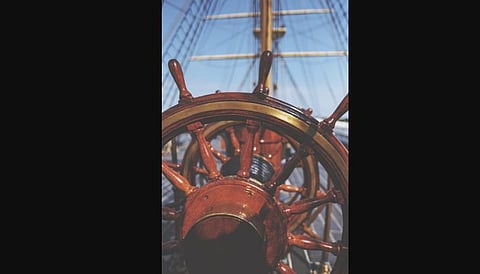

Before Vasco da Gama set foot in India on 27 May 1498, the trade route from India to the West, known as the spice route, had to traverse tricky seas, hostile winds, perilous deserts, regions of looting nomadic tribes, greedy sultans and so on. The chronicles of the journey sounded as if they were taken straight from the adventures of Sinbad the sailor. Seafarers like the Phoenicians, Arabs and Jews, and Venetian merchants used these stories to inflate the prices of the merchandise like spices like black pepper, cardamom, cloves and cinnamon. Among these spices, cloves and cinnamon came to Calicut (present-day Kozhikode) from Malacca (Malaysia) and Sri Lanka respectively. The trade of the Arabian Sea was controlled by the Arabs and Baniyas of Gujarat who took the cargo of pepper from Kerala and textiles from Cambay, reached Aden and then handed them over to Egyptian, Abyssinian and Arab merchants. The goods would then travel on land to Alexandria or Istanbul. Jewish merchants from Venice (remember Shylock of Shakespeare’s The Merchant of Venice) would buy the spices from these cities and distribute them all over Europe. The goods were sold with everyone making a profit with the poker-faced justification of the perils of collecting these spices that were protected by flying snakes and gigantic ferocious birds.
They never talked about the ease of navigation from the Horn of Africa to India using the wind that blows from the east coast of Africa to India, called Hippalus wind. For the Indians, this is known as the monsoon wind that starts blowing from mid-January till July. That ancient seafarers suggested that one should hire a local pilot from the region of the Horn of Africa (Malindi, Aden, etc.) to travel to India is known to us thanks to the Periplus of the Erythrean Sea. Even when da Gama reached the eastern coast of Africa in the late 15th century, there were agents, merchants and professional pilots settled in port cities like Zanzibar, Malindi, Aden and Hormoz, who undoubtedly knew about the passage to India using the Hippalus wind. Da Gama followed an instruction of the Periplus, written nearly 1,500 years earlier, and hired a pilot from Malindi to Calicut. The author of the journal of da Gama’s journey calls him Malemo Canaqua (Master Kanaka), who hailed from Gujarat. A broker named Davane, again a Gujarati, also joined da Gama from Zanzibar.
Both these Indians should be given the recognition of taking da Gama to Calicut. With this context, can anybody give the glory of discovery of India to da Gama as he did not find the sea route from Malindi to Calicut? One may argue that he should be praised for finding the direct sea route from Portugal to Malindi. But if we do so, we will be forgetting the contribution of Bartholomew Diaz, a genuine explorer who reached the Cape of Good Hope (now Cape Town) but had to return to Portugal due to financial and political pressure. He was the one who reported back to the Portuguese ruler that there was a possibility of travelling north from the Cape of Good Hope to reach India. Diaz’s report along with the information provided by Pero de Covilham, who visited Calicut and Kannur in 1487, convinced the Portuguese ruler that his nation was ready for a political alliance with Zamorin (Samutiri), the most powerful king of Kerala at that time. That is why he chose da Gama, whose resume showed his experience as an administrator, not an explorer. Actually, the Portuguese ruler had chosen Vasco Da Gama’s father for the expedition. Due to the unfortunate demise of his father, the responsibility fell on Vasco. An experienced explorer like Diaz was given the responsibility of the organisation of the voyage but not allowed to travel with da Gama.
Da Gama also believed that he was indeed an ambassador of Portugal, which is clear from the words with which he introduced himself to the Zamorin of Calicut. The author of the journal of da Gama’s voyage writes, “And the captain told him (Zamorin) he (Gama) was the ambassador of a King of Portugal, who was Lord of many countries and the possessor of great wealth of every description, exceeding that of any king of these parts (India).” However, when the Zamorin demanded gold in return for the trade agreement, da Gama retracted his words and pleaded that “he had brought nothing, because the object of his voyage was merely to make discoveries”. This statement created a lot of trouble to da Gama, who was ridiculed, insulted and even kidnaped by the “Moorish community” (read Mapplias of Calicut). Sanjay Subrahmanyam, in his The Career and Legend of Vasco da Gama, notes, “The anonymous account assures us when any Portuguese went ashore, the Muslim merchants would spit on the ground near them, and say ‘Portugali, Portugali’ in an insulting fashion.” Da Gama was annoyed with this treatment of the traders, silently supported by the Zamorin, and took drastic steps such as capturing a few Mappila merchants as hostages to retrieve his people ashore. At last, an agreement and a letter of acceptance were received and without much delay, the Portuguese decided to leave. Da Gama’s political ambition was unfulfilled in the 1498 expedition but he would return twice to Kerala, as Portuguese governor. He breathed his last in Kerala, landing where gave him universal fame as a great explorer—which he wasn’t. He was buried in the St. Francis Church at Cochin and later moved to Hironimus Monastery, Belem, near Lisbon.
To summarise, one can only state that Da Gama was not an explorer like Columbus, Magellan and Bartholomew Diaz, but an adventurous statesman.
Jayaram Poduval
Head, Department of Art History,
The Maharaja Sayajirao University of Baroda
(jpoduval@gmail.com)